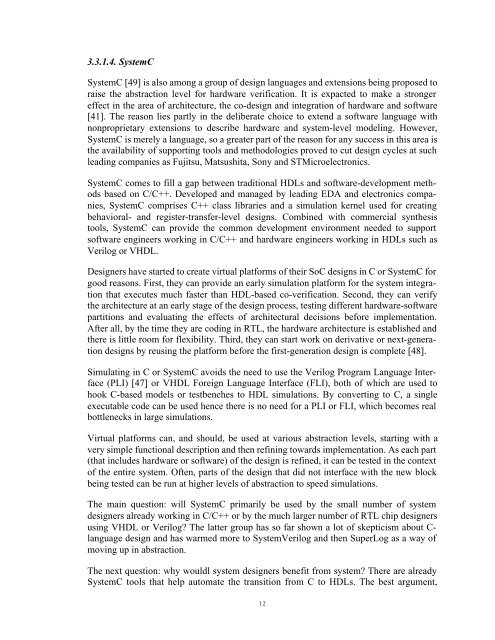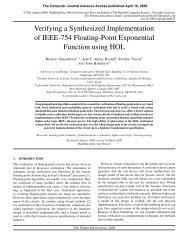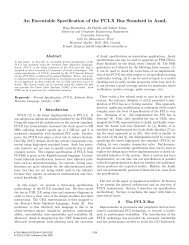PDF File - Hardware Verification Group - Concordia University
PDF File - Hardware Verification Group - Concordia University
PDF File - Hardware Verification Group - Concordia University
Create successful ePaper yourself
Turn your PDF publications into a flip-book with our unique Google optimized e-Paper software.
3.3.1.4. SystemC<br />
SystemC [49] is also among a group of design languages and extensions being proposed to<br />
raise the abstraction level for hardware verification. It is expacted to make a stronger<br />
effect in the area of architecture, the co-design and integration of hardware and software<br />
[41]. The reason lies partly in the deliberate choice to extend a software language with<br />
nonproprietary extensions to describe hardware and system-level modeling. However,<br />
SystemC is merely a language, so a greater part of the reason for any success in this area is<br />
the availability of supporting tools and methodologies proved to cut design cycles at such<br />
leading companies as Fujitsu, Matsushita, Sony and STMicroelectronics.<br />
SystemC comes to fill a gap between traditional HDLs and software-development methods<br />
based on C/C++. Developed and managed by leading EDA and electronics companies,<br />
SystemC comprises C++ class libraries and a simulation kernel used for creating<br />
behavioral- and register-transfer-level designs. Combined with commercial synthesis<br />
tools, SystemC can provide the common development environment needed to support<br />
software engineers working in C/C++ and hardware engineers working in HDLs such as<br />
Verilog or VHDL.<br />
Designers have started to create virtual platforms of their SoC designs in C or SystemC for<br />
good reasons. First, they can provide an early simulation platform for the system integration<br />
that executes much faster than HDL-based co-verification. Second, they can verify<br />
the architecture at an early stage of the design process, testing different hardware-software<br />
partitions and evaluating the effects of architectural decisions before implementation.<br />
After all, by the time they are coding in RTL, the hardware architecture is established and<br />
there is little room for flexibility. Third, they can start work on derivative or next-generation<br />
designs by reusing the platform before the first-generation design is complete [48].<br />
Simulating in C or SystemC avoids the need to use the Verilog Program Language Interface<br />
(PLI) [47] or VHDL Foreign Language Interface (FLI), both of which are used to<br />
hook C-based models or testbenches to HDL simulations. By converting to C, a single<br />
executable code can be used hence there is no need for a PLI or FLI, which becomes real<br />
bottlenecks in large simulations.<br />
Virtual platforms can, and should, be used at various abstraction levels, starting with a<br />
very simple functional description and then refining towards implementation. As each part<br />
(that includes hardware or software) of the design is refined, it can be tested in the context<br />
of the entire system. Often, parts of the design that did not interface with the new block<br />
being tested can be run at higher levels of abstraction to speed simulations.<br />
The main question: will SystemC primarily be used by the small number of system<br />
designers already working in C/C++ or by the much larger number of RTL chip designers<br />
using VHDL or Verilog? The latter group has so far shown a lot of skepticism about C-<br />
language design and has warmed more to SystemVerilog and then SuperLog as a way of<br />
moving up in abstraction.<br />
The next question: why wouldl system designers benefit from system? There are already<br />
SystemC tools that help automate the transition from C to HDLs. The best argument,<br />
12





